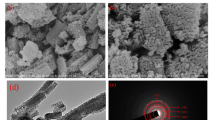Abstract
A self-assembled porous NiO nanorod nanocluster was reported in this work, which was prepared with the assistance of microwave-irradiation for 1–4 min. The obtained NiO nanocluster consistes of a few NiO nanorods, which are about 2–5 μm in length and 50–200 nm in diameter. The product were characterized by XRD, SEM and TEM and based on the observation it is believed that NiO nanoparticles are the building blocks to construct the structure of nanorod nanocluster. The NiO nanorod nanocluster is also fabricated as an anode material for rechargeable lithium ion batteries, which shows a high reversible capacity and good cycle life.
Similar content being viewed by others
References
Poizot P., Laruelle S., Grugeon S., Dupont L., and Tarascon J.M., Nano-sized transition-metal oxides as negative-electrode materials for lithium-ion batteries, Nature, 2000, 407(6803): 496.
Poizot P., Laruelle S., Grugeon S., and Tarason J.M., Rationalization of the low-potential reactivity of 3d-metal-based inorganic compounds toward Li, J. Electrochem. Soc., 2002, 149(9): A1212.
Lu Y., Wang Y., Zou Y.Q., Jiao Z., Zhao B., He Y.Q., and Wu M.H., Macroporous Co3O4 platelets with excellent rate capability as anodes for lithium ion batteries, Electrochem. Commun., 2010, 12(1): 101.
Shi Y.F., Wan Y., Zhang R.Y., and Zhao D.Y., Synthesis of self-supported ordered mesoporous cobalt and chromium nitrides, Adv. Fun. Mater., 2008, 18(16): 2436.
Du N., Zhang H., Chen B.D., Wu J.B., Ma X.Y., Liu Z.H., Zhang Y.Q., Yang D.R., Huang X.H., and Tu J.P., Porous Co3O4 nanotubes derived from Co4(CO)12 clusters on carbon nanotube templates: a highly efficient material for Li-battery applications, Adv. Mater., 2007, 19(24): 4505.
Rumplecker A., Kleitz F., Salabas E.L., and Schüth F., Hard templating pathways for the synthesis of nanostructured porous Co3O4, Chem. Mater., 2007, 19(3): 485.
Wang Y., and Lee J.Y., Microwave-assisted synthesis of SnO2-graphite nanocomposites for Li-ion battery applications, J. Power Sources, 2005, 144(1): 220.
Subramanian V., Burke W.W., Zhu H.W., and Wei B.Q., Novel microwave synthesis of nanocrystalline SnO2 and its electrochemical properties, J. Phys. Chem. C., 2008, 112(12): 4550.
Xu L.P., Ding Y.S., Chen C.H., Zhao L.L., Rimkus C., Joesten R., and Suib S., 3D Flowerliker-nickel hydroxide with enhanced electrochemical activity synthesized by microwave-assisted hydrothermal method, Chem. Mater., 2008, 20(1): 308.
Cho S., Jung S.H., and Lee K.H., Morphology-controlled growth of ZnO nanostructures using microwave irradiation: from basic to complex structures, J. Phys. Chem. C, 2008, 112(11): 12769.
Débart A., Dupont L., Poizot P., Leriche J-B., and Tarascon J.M., A transmission electron microscopy study of the reactivity mechanism of tailor-made CuO particles toward Lithium, J. Electrochem. Soc., 2001, 148(11): A1266.
Grugeon S., Laruelle S., Herrera-Urbina R., Dupont L., Poizot P., and Tarascona J-M., Particle size effects on the electrochemical performance of copper oxides toward Lithium, J. Electrochem. Soc., 2001, 148(4): A285.
Lu H.W., Li D., Sun K., Li Y.S., and Fu Z.W., Carbon nanotube reinforced NiO fibers for rechargeable lithium batteries, Solid State Sci., 2009, 11(5): 982.
Niasari M.S., Mir N., and Davar F., Synthesis and characterization of NiO nanoclusters via thermal decomposition, Polyhedron., 2009, 28(6): 1111.
Chen S.Q., Chen P., Wu M., Pan D., and Wang Y., Graphene supported Sn-Sb@carbon core-shell particles as a superior anode for lithium ion batteries, Electrochem. Commun., 2010, 12(10): 1302.
Song X., and Gao L., Facile synthesis and hierarchical assembly of hollow nickel oxide architectures bearing enhanced photocatalytic properties, J. Phys. Chem. C., 2008, 112(39): 15299.
Tao F.F., Guan M., Zhou Y., Zhang L., Xu Z., and Chen J., Fabrication of nickel hydroxide microtubes with micro-and nano-scale composite structure and improving electrochemical performance, Cryst. Growth Des., 2008, 8(7): 2157.
Chen S. Q., and Wang Y., Microwave-assisted synthesis of a Co3O4-graphene sheet-on-sheet nanocomposite as a superior anode material for Li-ion batteries, J. Mater. Chem., 2010, 20(43): 9735.
Shi C., Wang G., Zhao N., Du X., and Li J., NiO nanotubes assembled in pores of porous anodic alumina and their optical absorption properties, Chem. Phys. Lett., 2008, 454(1–3): 75.
Huang X.H., Tu J.P., Zhang C.Q., Chen X.T., Yuan Y.F., and Wu H.M., Spherical NiO-C composite for anode material of lithium ion batteries, Electrochim. Acta, 2007, 52(12): 4177.
Bai L., Yuan F., Hu P., Yan S., Wang X., and Li S., A facile route to sea urchin-like NiO architectures, Mater. Lett., 2007, 61(8–9): 1698.
Huang X.H., Tu J.P., Zhang C.Q., and Xiang J.Y., Net-structured NiO-C nanocomposite as Li-intercalation electrode material, Electrochem. Comm., 2007, 9(5): 1180.
Wang Y., Lu L.Q., and Wu F.D., Indium tin oxide@carbon core-shell nanowire and jagged indium tin oxide nanowire, Nanoscale Res. Lett., 2010, 5(10): 1682.
Author information
Authors and Affiliations
Corresponding author
Rights and permissions
About this article
Cite this article
Zou, Y., Wang, Y. Microwave-assisted synthesis of porous nickel oxide nanostructures as anode materials for lithium-ion batteries. Rare Metals 30 (Suppl 1), 59–62 (2011). https://doi.org/10.1007/s12598-011-0238-0
Received:
Revised:
Accepted:
Published:
Issue Date:
DOI: https://doi.org/10.1007/s12598-011-0238-0




